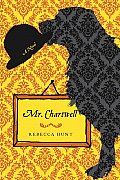
The central premise of
Mr. Chartwell is that
Winston Churchill's "black dog" of depression is made real — a walking, talking, monstrously-sized dog who weaves his way into the lives of both Churchill and a young widow named Esther Hammerhans. To his closer associates, the dog goes by the name Black Pat, and, as well as being duplicitous, dangerous and dark, he is also, I hope, funny.
One question I've been asked a lot regarding Mr. Chartwell is about the use of humour in a book that centers on depression. I suppose it seems an odd contradiction that the exploration of such a serious subject should also be humorous, especially when the hairy, bone-eating embodiment of depression is perhaps the most comedic character. It's something I thought about a lot whilst writing the book, and that I still think about now, probably because I know that humour will always be an integral part of any work I do.
I've always been attracted to dark and curious humour; I both enjoy it and am fascinated by the mechanics of it. I remember being the same as a child, and, when I was at Central Saint Martin's college studying fine art, I wrote my thesis about humour in art. So over the years I've had a long time to consider the part humour plays in my work, both in painting and writing, and I think I have identified a few of the reasons.
Most importantly for me, I don't believe that because something is funny it necessarily makes it superficial. As much as humour can embrace light observation, slapstick and anecdote, there is also scope for heartbreak, fear and disappointment. Used for these purposes, it's a tool that provides easier access, opening up an avenue of discussion to broach difficult or thorny topics and allow the conversation to move closer to the core of the matter than perhaps might be bearable if faced directly. Humour isn't reductive in these situations, somehow minimising or trivialising the matter. It's a form of permission, a giving of consent. The substance and weight of the issue remain, but now there is also a language through which it may be confronted.
Humour is also often used, with great effect, to express an opinion. Cannily managed, it can be highly persuasive. And, it can be deviously manipulative. Laugh along and you are offering your collusion, showing you understand the argument — that, yes, you agree. In this way, it can expose a stance that perhaps you wouldn't be comfortable voicing publicly. But the joke makes this okay. After all, it's only a joke, right? I'm not so sure. Behind every joke is a truth — and that includes a nasty, hateful joke. The ability of humour to unearth qualities, not necessarily bad, but buried nonetheless, or concealed to some extent, makes it a deceptively powerful device — and one I find compelling.
Perhaps for me one of the most poignant forms of humour is its ability to convey courage. It takes a certain courageousness and strength to find humour when frightened. Far from showing an inability to comprehend the situation, or a refusal to engage it, humour can be a battle-cry. People in my life, coping with serious illness, for example, have shown extraordinary bravery. Even during the most desperate times, in the furthest place from funny, their sense of humour remained. I think it was a display of kindness to others, a way of protecting them. It's a deeply admirable quality which I kept in mind as I wrote Mr. Chartwell, and that I hope is reflected in the book.
These are just a few of the myriad ways humour reflects the people we are. The breadth and complexity of humour makes it a fundamental part of human nature, defining and allying us. And, ultimately, laughter unites us, because, in essence, a joke of whatever context is the contributor asking, "Are you with me?" The recipient's laughter responds, "I am."